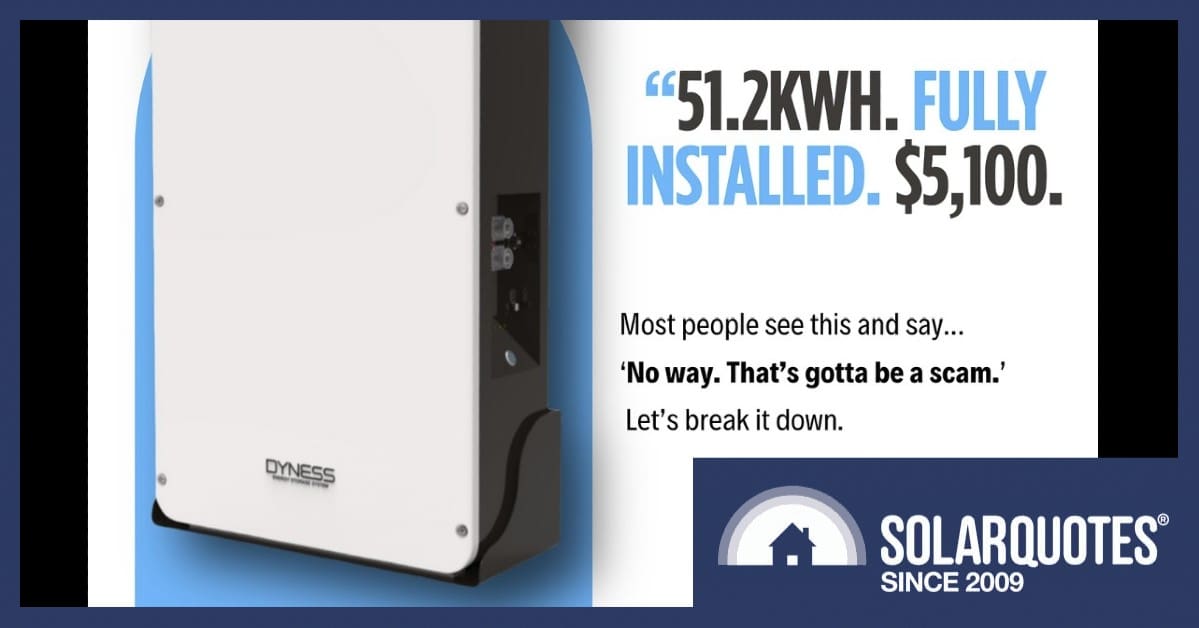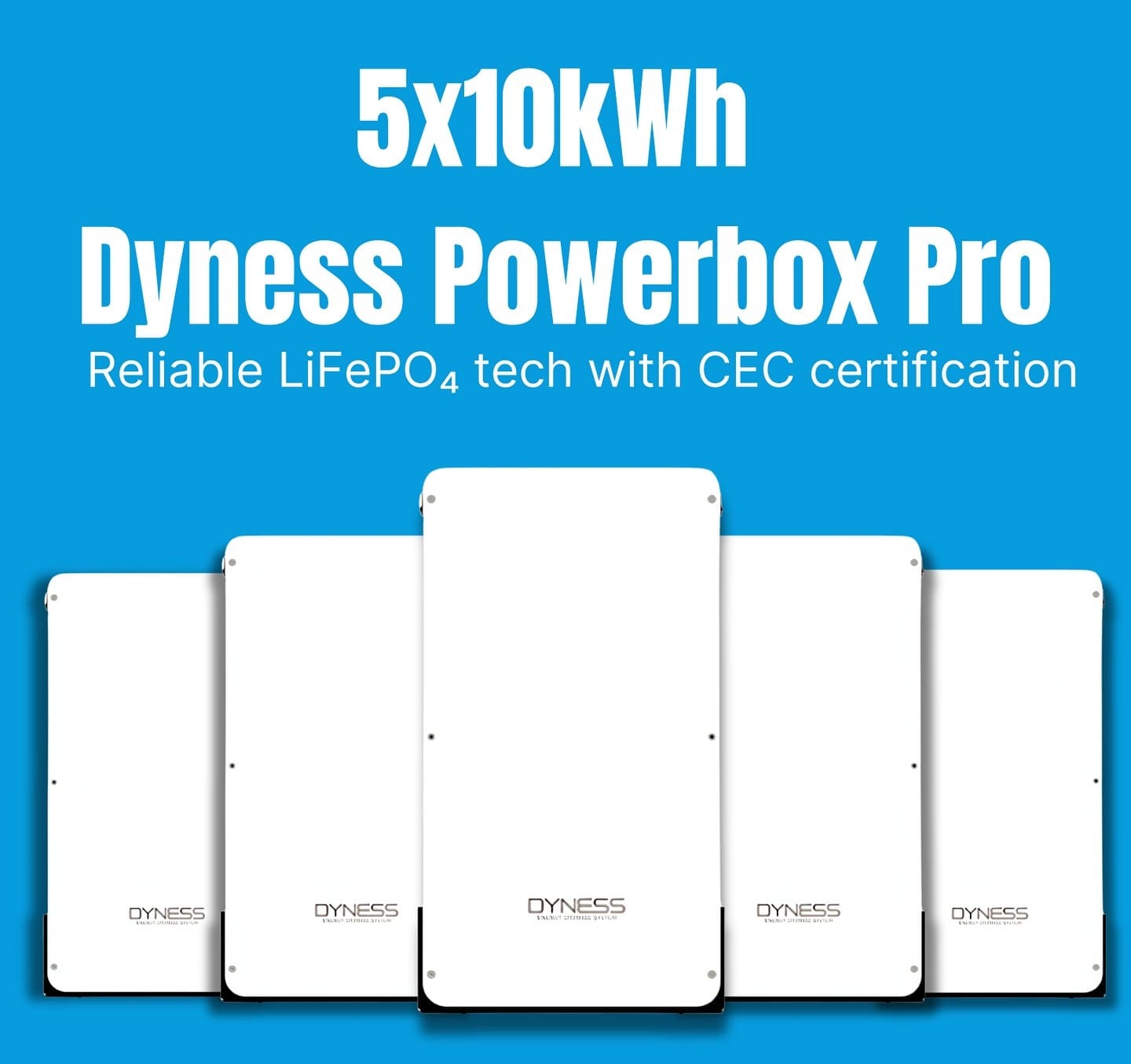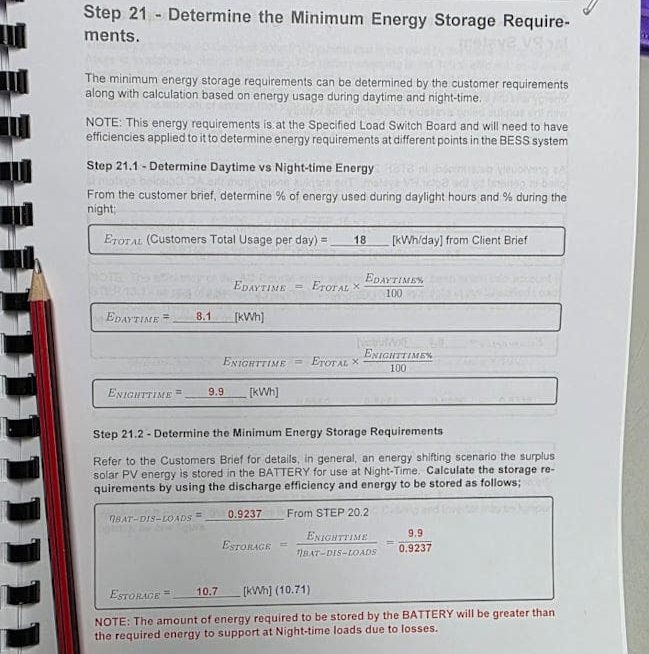
 On the back of the federal rebate, huge batteries are on sale for bargain prices. There’s a catch to many of these deals however: you can’t possibly hope to actually charge these monster batteries to capacity as they are paired with completely inadequate inverters. Here’s what to watch out for.
On the back of the federal rebate, huge batteries are on sale for bargain prices. There’s a catch to many of these deals however: you can’t possibly hope to actually charge these monster batteries to capacity as they are paired with completely inadequate inverters. Here’s what to watch out for.
In a bid to make the rebate useful for businesses, the Cheaper Home Batteries Program discounts as much as 50 kWh of the usable capacity of a battery system – much more than most residential households could need.
This in turn has sparked an arms race of advertisements promoting ever-bigger batteries at ever-smaller prices for homes that simply don’t need them. The cheapness however isn’t just down to the rebate discount – there’s something crucial these batteries are missing.
All Capacity, No Power
My old mate Sam had a Landcruiser “shorty” called Daisy. The previous owner had installed an additional fuel tank, more than doubling the total capacity to 183 litres. With a modest 85kW 4 cylinder using 7.8litres/100km (30mpg) Daisy had a ludicrous range of 2300km. That’s almost Adelaide to Perth, 25½ hours straight.
So if you get a 5kW inverter and a 50kWh battery as we’ve seen advertised in one instance, you’ve got the same combination: modest power output and a novelty oversized tank. The trouble is this doesn’t offer the same advantage that it is does for a car’s range. An average full day of sunshine on 6.6kW of solar will only half fill the battery. Or charging from the grid, sweating its arse off, the inverter will take 10 hours straight.
Once filled, you wouldn’t be able to extract the energy particularly fast either: 6kW to run the toaster, kettle and dishwasher would mean you’re still importing energy from the grid despite a charged battery. And the backup capacity from a 5kW inverter isn’t going to run your whole house in a blackout.
A general rule of thumb, subject to your particular needs, is a 2 or 3-to-1 ratio for battery and inverter size: so a 5kW inverter being appropriate for a 10kWh or 15kWh battery.
Be Aware Of Power and Kilowatt Hours
The key is to understand the difference between kilowatts (peak rating) and kilowatt hours (storage units).
For another car analogy:
- Kilowatts is the grunt under the bonnet. Going fast means you need more peak ‘orsepower under your right foot.
- Moving your car means doing work, using litres of petrol in the tank, measured slowly and accurately into the engine, burnt gradually over time.
- In other words, an aerodynamically efficient car might need 15 kilowatts of power to move it through the air.
- So if you’re consuming 15 kilowatts to keep a steady speed for an hour, that’s 15kW/h of energy out of your tank.
The Worst Example Yet
In what is the worst example I’ve seen to date, a crowd that’s been importing 4WD accessories for all of five years has just set up a brand new ABN for an energy business. They’re doing a “group buy” taking your money in advance so they don’t have to carry the capital cost.


50kWh of battery for just $5100 sounds like an unbelievable deal …


Until you see it is paired with a hopelessly undersized 5kW inverter.
The promise is FIFTY kilowatt hours of storage for $5100 installed.
- Do they realise that as the importer, they’re responsible for warranty under Australian Consumer Law?
– I’m not sure the gravity of that obligation has struck them - Are they approved to parallel import when there’s a local office for the battery?
– That’s worth asking - Have they priced in some after-sales support and warranty stock?
– They’re not transparent on prices, but obviously the federal rebate is paying more than the battery costs - Do they care?
– Apparently they’re out to break the solar industry - Have they designed the system properly?
– No. We can say that categorically.
The qualification I’ve done to be a certified solar and battery electrician goes into great detail. We’re trained to examine the customer’s infrastructure, their electrical loads, their peak demand, their potential solar yield and most importantly, the amount of surplus energy they should have available to fill a battery.
Flogging everyone the same massive battery ignores all of this detail.


Not every designer is going to run every calculation, but being trained means knowing the process.
Can’t Huge Batteries Just Export For Huge Profit?
Worse still, expecting a system to perform properly and claiming you can make wads of cash using a retailer that offers wholesale prices like Amber with 70c/kWh for export is not right.
With 10 times more battery than inverter capacity, it’ll take ten hours to export a full battery for a princely $3.50 per hour. Never mind that you’ll need two days of average solar yield to fill the battery first, as the inverter supplied isn’t actually integrated with Amber smart-shift.
Energy trading relies on being able to respond quickly to 5 minute price fluctuations. So if there’s a “grid event” and the prices go berserk, you need to automatically export a heap of energy during an short window of time.
If the spot price is on fire, a 30kw inverter might occasionally earn a $20 bonus or $200 bonanza in a fleeting half-hour, but with a 5kw inverter, you’ll be fighting a bushfire with a garden hose… and without smart-shift, you’ll have to be on the app to make a manual intervention at just the right time.
Whatever The Question, The Answer Is More Solar
Inverters aren’t the only issue: how much solar you have is also key. I’ve always maintained that the question doesn’t matter, more solar is always the answer, because generating your own energy is cheaper than importing it and “excess” solar isn’t a thing. Even if the networks resort to export charges instead of feed-in tariffs, setting your system for zero export will zero the problem.
You need extra energy, over and above your daytime loads, to charge up a battery. Qualified solar and battery designers can explain how they specify a solar power system to generate “excess” electricity, and how much battery capacity you need to store this surplus.
So you can come at the problem by working out:
- the storage required to cover your dusk till dawn consumption,
- adding some extra capacity to account for degradation,
- then installing enough solar to harvest what’s required to fill the battery
- and enough to satisfy your daytime appetite.
Or you might have a limitation like roof size or budget constraint, in which case it’s a matter of :
- working out your maximum solar yield,
- subtracting the daytime demand,
- arriving at the battery capacity to store the surplus,
- adding some storage if the budget allows,
- charging this extra battery capacity by importing cheap off-peak electricity.
We Should Have A Second Bite
Part of the problem with the oversized battery epidemic is that households can only claim the rebate once, meaning there’s a temptation to go big or go home. This would be addressed if the battery rebate worked more like the solar rebate, which can be had in any number of increments up to 100kW of installed capacity.
Indeed in the early days, many commercial customers started with 10kW, jumped to 30kW the following year and then really bit the bullet for 99.99kW once they were sure the savings were stacking up.
It would be great to see the same logic applied to the battery rebate. People could buy what they can afford without overcapitalising on something out of fear. A lot of quotes I’ve seen mean a lot of battery capacity is going to be installed, but there’s a risk it will be effectively stranded behind a small inverter.
The first 5kWh of battery capacity offers great benefit to the grid by lopping peak demand, but for public infrastructure owners (the electricity network operators) the savings grow smaller as battery sizes increase.
For domestic customers, I expect 10 to 15 kWh will be a sweet spot in terms of value, again with diminishing returns if batteries grow significantly more.
As bad as going too big is, that’s arguably not the worst you can make with this one-shot rebate. That might be going for too small a battery: I’ll cover this in an upcoming article.
For more on battery capacity, read our deep-dive explainer on battery sizing.
